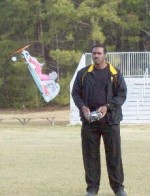
Frazier’s engineering graphics class in the Department of Engineering Technology pursued a special class project this semester. The students designed and built a “car-plane” flying device. Frazier explained the purpose of the project was to help students understand the design process and use techniques involved in engineering technology.
The “car-plane” project was the result of positive feedback from students and others after the successful completion of the UFO project last fall.
Frazier’s engineering graphics class designed and constructed a similar disk-shaped flying device they called a UFO.
The UFO flying device was lightweight and did not have wheels or a landing gear. Some students and others, were skeptical that the UFO would fly.
When the test flight day arrived, the UFO took flight and the project was a success.
“The students were excited about the project and the things they had learned,” he said.
The decision was made to design and build a device that would be controllable on the ground and in flight, thus the “car-plane” idea.
The students began the project just as any professional engineer would by creating a sketch, and converting it into a detailed scale drawing.
The students proceeded to build the “car-plane” according to their drawing.
This device is disk-shaped, but has a steering unit and wheels to allow for ground control, and elevons, rudder and elevator, etc. for controlling while in flight.
The device is environmentally friendly as it uses green technology.
It is powered by electric components rather than fuel and uses a 950 MAH lithium polymer battery and a 1300 KV brushless motor.
The “car-plane” flying device is radio controlled by state-of- the-art technology, a Spectrum 2.4 GHz radio control modulations system.
It operates on the same frequency as most cell phones. However, Frazier said, this system is practically free from other modulation frequency interference. Although similar disk-like devices exist, through various modifications, Frazier and his students designed a unique device.
When test demonstration day arrived, the students and Frazier were anxious to see if their “car-plane” device would perform as they planned.
The class, department head, Dr. Olusegun Adeyemi, Dr. Danny Hubbard, Interim associate dean of the College of Arts and Sciences and other faculty members assembled to watch the test flight of the “scar-plane” the students designed and built.
Frazier, with radio in hand drove the aerobatic car-plane around before putting it into flight. During flight, the device performed aerobatic maneuvers such as loops, rolls, tight turns, touch and goes, and hovered like a helicopter. The aerobatic “car-plane” flying device project was a success.
Students in the engineering graphics classes benefited from working with the project.
“I was very excited to see the project actually work. It was remarkable and something I will remember forever. I learned about designing and the mechanical and electrical components required to build something that would fly,” said Loomis Martin, a freshman from Cleveland, Ohio.
Norris Green, a senior from Ferriday, who worked on the project said, “The project helps you to understand the design process and the importance of teamwork. I also learned that something very extraordinary could be made from simple items such as foam, toothpicks, glue and electric motors.”
Dion Watson, freshman from West Palm Beach, Fla. said, “I really enjoyed working on the car-plane project. This showed me what engineering technology is all about, the importance of teamwork and the sophisticated electronic devices used.”
He said, the aerobatic car-plane project has inspired me to explore all aspects of engineering technology. This car-plane project is just a sample of what engineering technology students are capable of doing.
“I learned a lot from the project and that the design process requires precision and attention to detail. It was a great experience,” said Tchounke (Marcus) Ngwameni, a freshman.
Frazier said he was proud of the support from Dr. Adeyemi, and Dr. Edwin Thomas, coordinator of the drafting and design engineering technology program.
“My colleagues have been very supportive of the student projects,” said Frazier.
